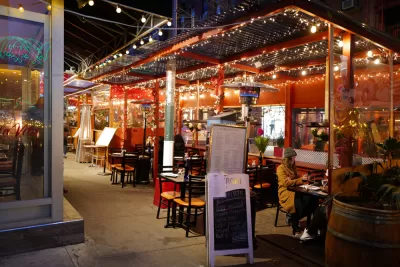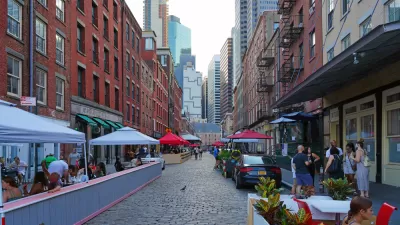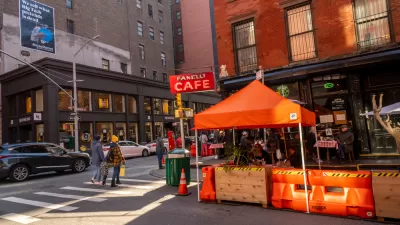A proposal to shift responsibility away from the Department of Transportation has met staunch resistance from industry groups and advocates of the program.

Writing in Streetsblog NYC, Kevin Duggan reports on the uncertain future of New York City’s outdoor dining program, which has been administered by the city’s Department of Transportation (DOT) since its inception in the early days of the Covid-19 pandemic. Since then, the program became ten times bigger than a prior sidewalk dining program managed by the Department of Consumer and Worker Protection (DCWP) and, according to some, propped up the industry during the pandemic.
The 0.3-percent reduction in private car storage for Open Restaurants saved some 100,000 jobs during the coronavirus crisis, city officials estimate, and it is still driving Gotham’s slow comeback by helping restaurants make up for pandemic losses, according to the executive director of the New York City Hospitality Alliance, which represents tens of thousands of restaurants.
A bill proposed in February would shift management of the program to the DCWP and bar restaurants from erecting outdoor dining structures in the winter months, “a non-starter, restaurateurs previously told Streetsblog because of the cost to build, dismantle and store sheds every year simply because of a winter ban.” Duggan notes that Streetsblog and restaurant industry groups have unsuccessfully tried to get answers from the bill’s sponsor, Council Member Marjorie Velázquez (D–Bronx).
Opponents of the proposal say it would “essentially kill” the outdoor dining program, and that “The $1.4-billion DOT is far better equipped to handle the mammoth initiative than the $70-million DCWP.” Restaurant owners say DOT has been a more collaborative partner, with one owner saying, “I think that [DOT] have their priorities right,” unlike DCWP, who are perceived as “punishers” rather than partners.
FULL STORY: Mayor Adams: Keep DOT in Charge of Open Restaurants

Study: Maui’s Plan to Convert Vacation Rentals to Long-Term Housing Could Cause Nearly $1 Billion Economic Loss
The plan would reduce visitor accommodation by 25,% resulting in 1,900 jobs lost.

North Texas Transit Leaders Tout Benefits of TOD for Growing Region
At a summit focused on transit-oriented development, policymakers discussed how North Texas’ expanded light rail system can serve as a tool for economic growth.

Why Should We Subsidize Public Transportation?
Many public transit agencies face financial stress due to rising costs, declining fare revenue, and declining subsidies. Transit advocates must provide a strong business case for increasing public transit funding.

How Community Science Connects People, Parks, and Biodiversity
Community science engages people of all backgrounds in documenting local biodiversity, strengthening connections to nature, and contributing to global efforts like the City Nature Challenge to build a more inclusive and resilient future.

Alabama: Trump Terminates Settlements for Black Communities Harmed By Raw Sewage
Trump deemed the landmark civil rights agreement “illegal DEI and environmental justice policy.”

Dear Tesla Driver: “It’s not You, It’s Him.”
Amidst a booming bumper sticker industry, one writer offers solace to those asking, “Does this car make me look fascist?”
Urban Design for Planners 1: Software Tools
This six-course series explores essential urban design concepts using open source software and equips planners with the tools they need to participate fully in the urban design process.
Planning for Universal Design
Learn the tools for implementing Universal Design in planning regulations.
City of Santa Clarita
Ascent Environmental
Institute for Housing and Urban Development Studies (IHS)
City of Grandview
Harvard GSD Executive Education
Toledo-Lucas County Plan Commissions
Salt Lake City
NYU Wagner Graduate School of Public Service




























